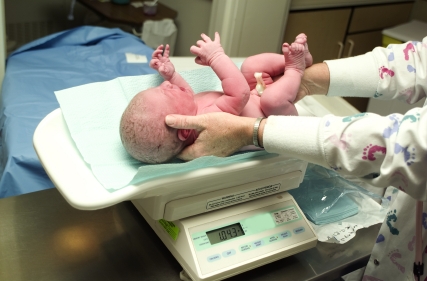First Examination

The doctor usually gives the newborn a thorough physical examination within the first 12 hours of life. The examination begins with a series of measurements, including weight, length, and head circumference. The average weight at birth is 3.2 kg, and the average length is 45cm, although there is a wide range that is considered normal. Then the doctor examines the baby's skin, head and face, heart and lungs, nervous system, abdomen, and genitals.
The skin is usually reddish, although the fingers and toes may have a bluish tinge because of poor blood circulation during the first few hours. Occasionally, the skin has several hard lumps (subcutaneous fat necrosis) where pressure from bones destroyed some fatty tissue. Such lumps are most common on the head, cheek, and neck, particularly if forceps were used during delivery. The lumps may break through to the skin surface, releasing a clear yellow fluid, but they usually heal fairly quickly.
A normal head-first delivery leaves the head slightly misshapen for several days. The bones that form the skull overlap, which allows the head to become compressed for delivery. Some swelling and bruising of the scalp is typical. Sometimes bleeding from one of the bones of the skull and its outer covering causes a small bump on the head that disappears in a few weeks. When the baby is delivered buttocks first (breech delivery), the head is usually not misshapen; however, the buttocks, genitals, or feet may be swollen and bruised. Delivery of a baby in the breech position is now usually avoided. When the baby is in the breech position, doctors usually recommend a cesarean or C section (surgical delivery of a baby by incision through a woman's abdomen and uterus), which minimizes danger to the baby.
Pressure during a vaginal delivery may bruise the newborn's face. In addition, compression through the birth canal may make the face initially appear asymmetrical. This asymmetry sometimes results when one of the nerves supplying the face muscles is damaged during delivery. Recovery is gradual over the next few weeks.
The doctor listens to the heart and lungs through a stethoscope to detect any abnormality. The doctor inspects the newborn's skin color and general condition for any sign of a problem. The strength of the pulse is checked.
The doctor looks for any abnormalities of the nerves and tests the baby's reflexes. A newborn's most important reflexes are the Moro, rooting, and sucking reflexes.
Many serious disorders that are not apparent at birth can nonetheless be detected by blood tests in newborns. Because of this, all states require a number of blood tests in newborns. Early diagnosis and prompt treatment can reduce or prevent disorders that may interfere with an infant's healthy development.
The doctor examines the general shape of the abdomen and also checks the size, shape, and position of internal organs, such as the kidneys, liver, and spleen. Enlarged kidneys may indicate an obstruction to the outflow of urine.
The doctor examines the flexibility and mobility of the arms, legs, and hips, and checks to see if the newborn has dislocated hips.
The doctor examines the genitals to ensure the urethra is open and in the proper location. In a boy, the testes should be present in the scrotum. In a girl, the labia are prominent because of exposure to the mother's hormones, and they remain swollen for the first few weeks. The doctor examines the anus to make sure the opening is not sealed shut.
Three Common Reflexes of Newborns
In the Moro reflex, when newborns are startled, their arms and legs swing out and forward in a slow movement with fingers outstretched.
In the rooting reflex, when either side of their mouth is touched, newborns turn their head toward that side. This reflex enables newborns to find the nipple.
In the sucking reflex, when an object is placed in their mouth, newborns begin sucking immediately.
Also see APGAR Score
Please see the following:


